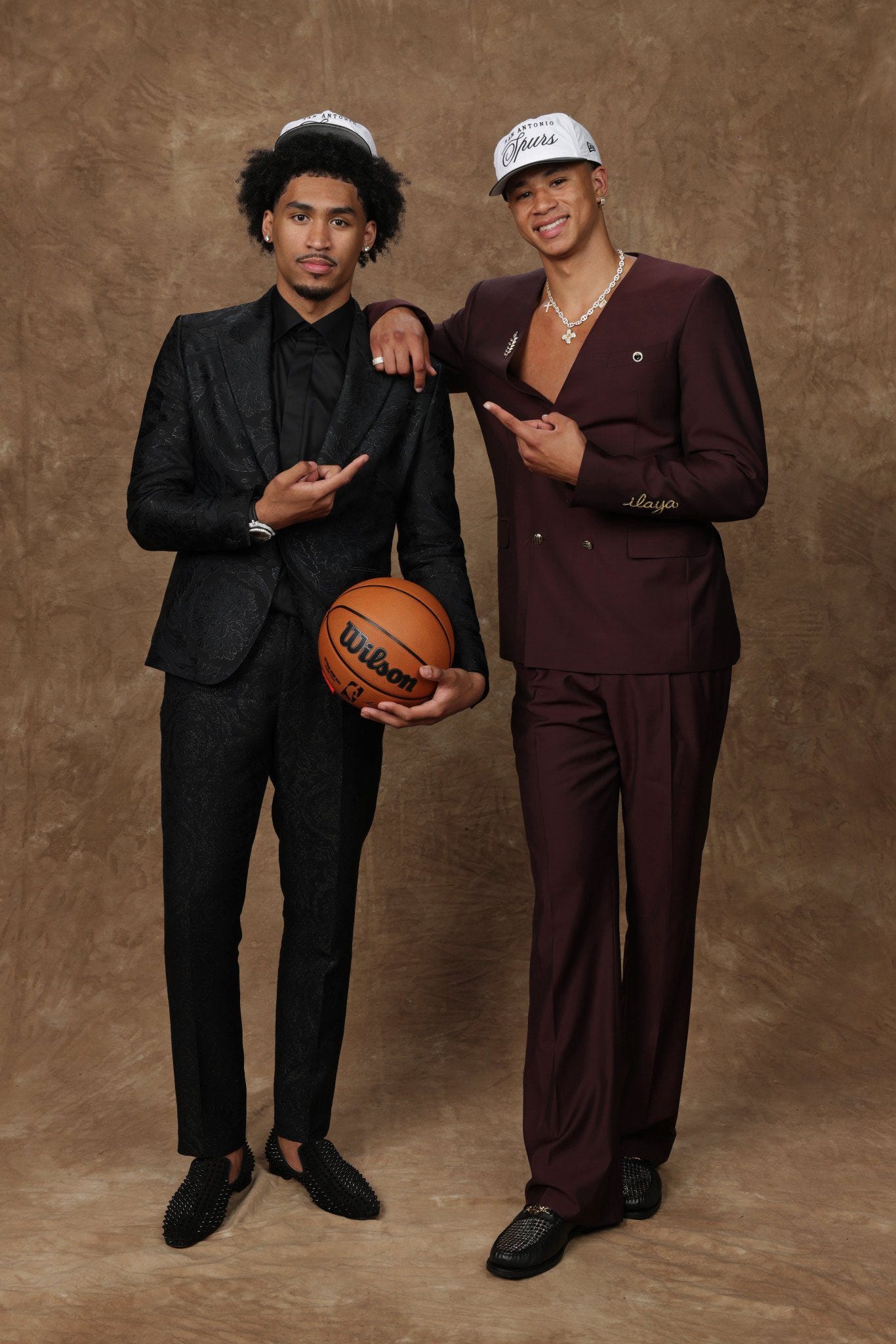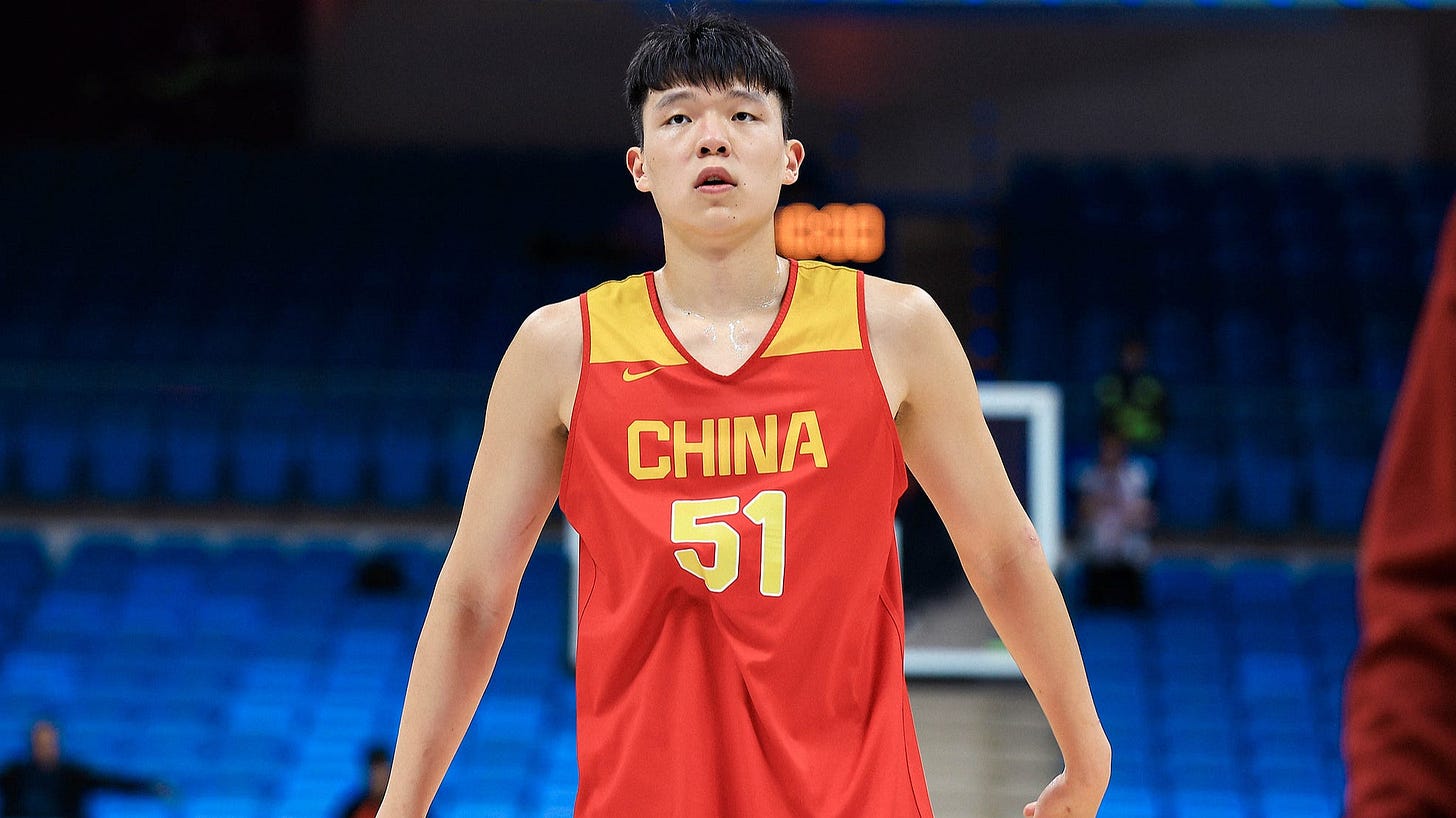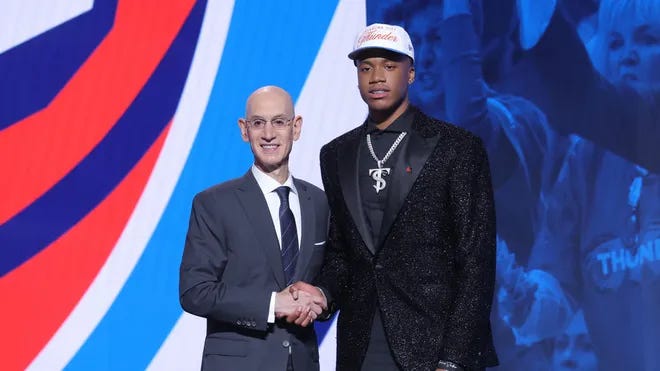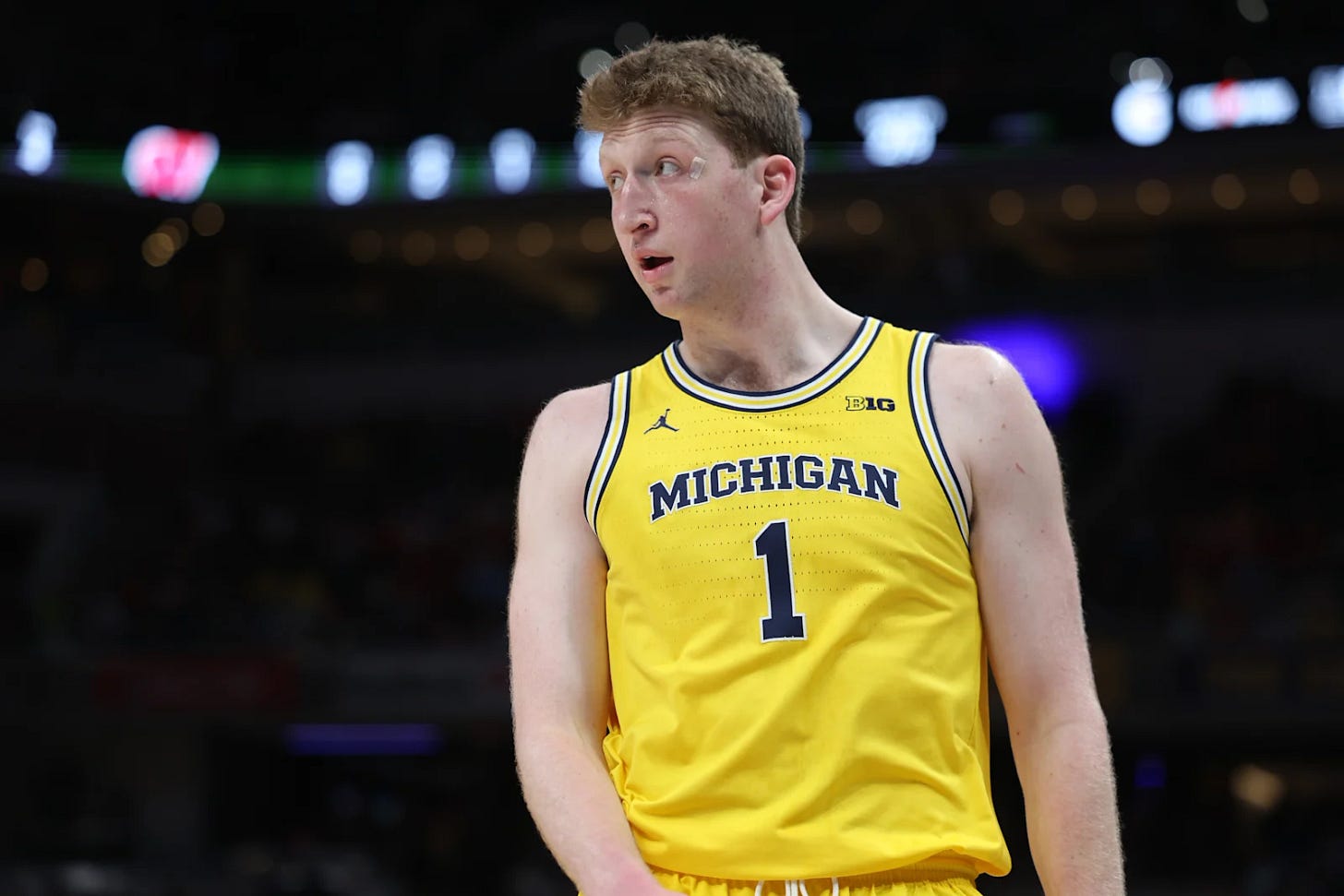NBA Draft Breakdown: Winners and Losers of the First Round
On Wednesday, the first round of the 2025 NBA Draft went down, and there was no shortage of surprises and storylines. Today, I’m breaking down which franchises had the best and worst performances on the day.
Winner #1: Onsi Saleh and the Atlanta Hawks
Onsi Saleh was promoted as the Atlanta Hawks’ president of basketball operations on April 21st of this year, and he has already knocked it out of the park.
In addition to trading for Kristaps Porzingis on a bargain — much to my lament — he pulled off a masterclass in round one of the NBA Draft on Wednesday.
The Hawks owned the 14th overall pick in the draft and ultimately traded it to the New Orleans Pelicans for the 23rd overall pick and an unprotected 2026 first-round pick. That pick is a swap, meaning the Hawks now own the most favorable draft selection between Milwaukee and New Orleans next year. Here are the full details:
This move is genius on several fronts. First of all, that 2026 pick is an absolute gem. Milwaukee is cast away at sea, holding onto the Giannis liferaft by one finger, and the Pelicans are highly unlikely to win more than 45 games. In other words, the draft pick will almost certainly be a lottery pick. Extracting that type of value to move down 10 spots is unheard of.
Moreover, the Hawks still got a great player by moving back this year. With the 23rd pick, they selected Asa Newell, who was projected to go 16th overall. Thus, it seems the Hawks still got the guy they wanted, but added another highly coveted lottery pick for next season. Good job, Onsi Saleh.
But that brings me to the other side of this trade…
Loser #1: Joe Dumars’ Job Security
Bill Simmons called this trade one of the “dumbest of the decade,” and I agree. Joe Dumars also received his role as the president of basketball operations in April of 2025, but he has not gotten off to as good a start as Saleh. In fact, Saleh is the reason that Dumars may not have a job in 12 months.
Trading away that 2026 first-round selection just doesn’t make any sense. As previously mentioned, that pick is bound to be a lottery pick, and for a New Orleans team that has suffered mediocrity since its inception, keeping that pick is in their best interest. Most teams that move up 10 spots wouldn’t give up nearly that much value, but leave it to the Pelicans to set new precedents for dysfunction.
If Dumars was truly set on moving up, he could’ve placed a top-7 or top-10 protection on the pick, and Atlanta likely still would’ve accepted. In that event, New Orleans could make the trade, but still gamble on keeping the pick next year. Dumars was reckless with this move.
In addition, the Pelicans’ selections were questionable.
Their seventh overall pick, Jeremiah Fears, is a walking red flag. He is massively turnover-prone, shoots it poorly from three (but loves to shoot), misses open teammates, struggles on defense, and is undersized. In a pre-draft article that I never completed, I had Jeremiah Fears as my biggest bust of the draft. Oh, and he’ll be playing alongside Jordan Poole. I don’t think I need to say much more.
In the aftermath of their dramatic trade, the Pelicans drafted Derik Queen, one of the most polarizing prospects in the draft. Queen is abundantly gifted on offense and has a huge frame, but has several question marks regarding his defense and physicality. All things considered, I think he will develop into a good NBA player and fit well in New Orleans — but for a guy that could’ve been available a few picks later, they are hinging far too much draft capital on his future.

Winner #2: The San Antonio Spurs
After having back-to-back Rookie of the Year players in Victor Wembanyama and Stephon Castle, the San Antonio Spurs found themselves with the #2 and #14 overall selections in this year's draft.
The #2 pick was a no-brainer. Dylan Harper from Rutgers was far and away the second-best prospect in this draft, with all the tools to become a perennial All-Star. He has all the tools and cerebral ability of a true point guard, but the frame and physicality of a small forward. His best NBA comparison is Cade Cunningham.
There were some concerns about adding Dylan Harper in a rotation alongside both De’Aaron Fox and Stephon Castle, but I believe that will all work itself out. First of all, the Indiana Pacers are proof that teams can play multiple guards/wings at the same time and be incredibly effective. Alternatively, this gives them a boatload of roster flexibility. If Harper doesn't pan out, or De’Aaron Fox is a clunky fit by his side, they can change things easily down the road. Taking the best player available was the right move here.
With the 14th overall pick, they took Carter Bryant, and I see this as a perfect fit. Bryant is the epitome of a 3-and-D wing in the modern NBA, and the San Antonio system will be perfect for him. First of all, the Spurs are weak on the wings, and he will be able to fill rotational minutes immediately. With the best shot blocker in the world in the paint, Bryant guarding on the wings, and Castle and Harper guarding on the perimeter, the Spurs have the makings of a young, defensive juggernaut — some shades of OKC?
The biggest question with Bryant was his ability to develop as an on-ball creator. Despite his success in college, he was mostly a spot-up shooter, smart cutter, and play finisher. In other words, he didn’t create for himself. Well, in San Antonio, he won’t have to. With Fox, Castle, Harper, and Wemby all creating their own shots in the paint, Bryant can do what he does best: create off the ball.
San Antonio is back.
Loser #2: Logical Roster-Building in Portland
The Portland Trail Blazers had the 11th overall selection in the draft, ultimately taking Cedric Coward. Coward seemed like a logical fit for Portland: an athletic, high-ceiling, 3-and-D wing that would complement their new identity as a young, defensive-minded core and fill a major gap on the wing.
Then, in a shock, the Trail Blazers traded Coward to the Grizzlies for the 16th overall pick and a 2028 first-round pick. Then, with the 16th pick, Portland drafted Yang Hansen, a center from China who was projected to go in the last few selections of the first round.
Hansen was a stretch at 16 for any team, but the case can be made. He’s an offensive hub at 7’2, and has plenty of defensive upside. His claims to be the “Chinese Jokic” are lofty, but the playstyle is similar.
But for Portland, this really doesn’t make any sense. The Trail Blazers already have three starting-caliber centers on the roster with Deandre Ayton, Robert Williams, and Donovan Clingan. Not to mention, they used their first-round pick on Clingan last year, who plays a very similar style to Yang.
I like Hansen, but he has no place in Portland. Instead of filling a massive need with Coward on the wing and deepening an exciting young, defensive core, the Trail Blazers worsened their logjam at center in an unprecedented fashion.
Winner #3: The Rich get Richer in Oklahoma City
As you know, the Oklahoma City Thunder just won the 2025 NBA Championship. With the second-youngest championship team in NBA history and a treasure trove of draft picks in the future, OKC is perfectly set up to avoid the ever-dreaded second-round woes.
However, one thing stood in their way. With Jalen Williams and Chet Holmgren due for maximum contract extensions next summer, their current roster construction was bound to eclipse the second apron. Thus, they will have to shed salary when they reach that point in July of 2026.
The most expensive contract on the Thunder, outside of Shai Gilgeous-Alexander, is Isaiah Hartenstein. Hartenstein is a great big man and vital to the Thunder’s success, especially as a supplemental big when Chet Holmgren inevitably gets hurt every season. However, the Thunder can’t afford him in the summer of 2026.
So, Sam Presti smartly selected Thomas Sorbers from Georgetown with the 15th overall pick in this year’s draft. Sorbers, a 6’10 big man, is a physical screener, rebounder, and a great playmaker at the center position. He fills every role that Hartenstein will leave behind in 2026, and has a year or two to find his footing before playing serious minutes for a championship contender.
Loser #3: The Brooklyn Nets
The Brooklyn Nets boasted four picks in the first round of the NBA Draft, with the 8th, 19th, 26th, and 27th selections. With all that draft capital, Brooklyn was a virtual lock for moving up in the draft and securing a highly coveted prospect.
As the first six picks passed, it was clear Brooklyn couldn’t move up. So, the next move was using those picks to draft a variety of exciting talent to fill out a very bleak roster. Spoiler: they did not do that.
With the 8th overall selection, they selected Egor Demin, a point-forward from BYU. Demin has plenty of upside as the best passer in the draft, but his shooting woes and skinny frame had him projected later in the lottery. Still, this seemed like a decent gamble from Sean Marks and the Brooklyn Nets.
And then things got weird. With the 19th and 26th picks, the Nets took Nolan Traorè and Ben Saraf — two ball-handlers with shooting woes and bad physical profiles. Essentially, they drafted Egor Demin three times.
Then, in an even stranger move, they drafted Danny Wolf — the only center in the draft who plays like a guard. Wolf is a more intriguing fit for Brooklyn, but he is far more effective running the offense than operating on the block.
Essentially, the Brooklyn Nets drafted four players who all need the ball in their hands to be effective. Unfortunately, the sport of basketball is only played with one ball.
I won’t get into the specifics, but there were plenty of players that Brooklyn could’ve taken that would’ve been much more promising for their roster. It simply doesn’t make sense to take four players who all play a very similar role on a team that needs help in a variety of places.
The Nets wasted this draft.








